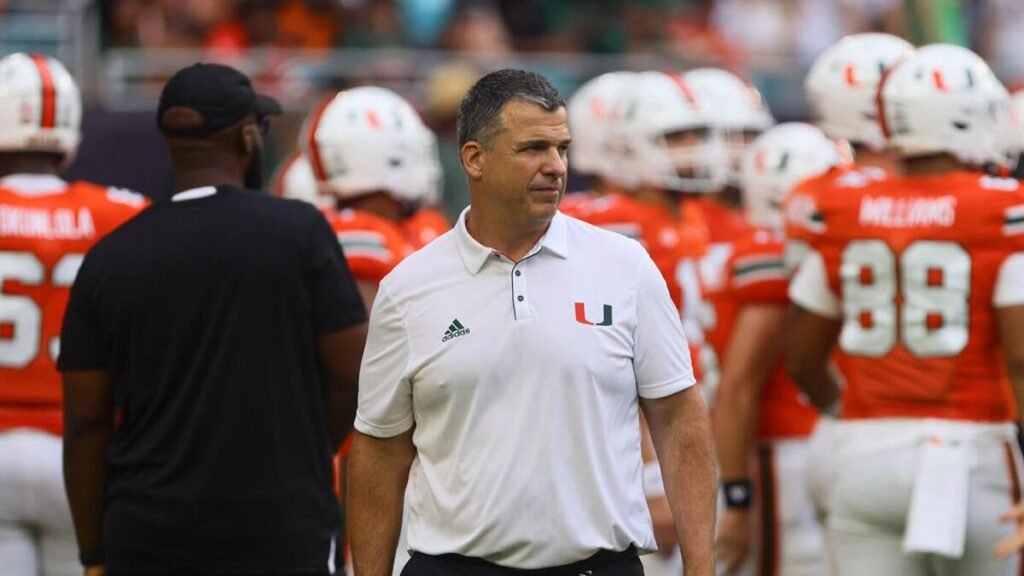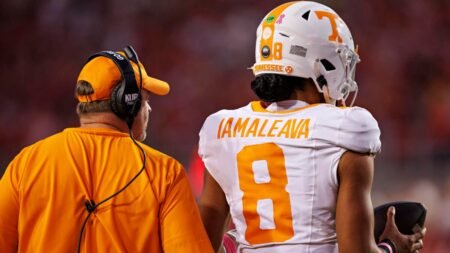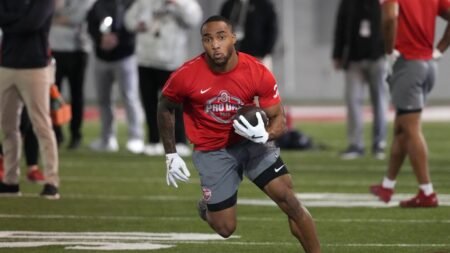College football’s spring transfer portal window is just days away ahead of its April 16 opening. That window, the first time undergraduate players can enter the portal since January, will run through April 25.
The spring window won’t see the same sort of volume that the winter did in terms of entries and quality, but the previous two cycles have still seen 1,000-plus FBS players enter during the spring. The volume could be higher this year as programs face potential roster cuts ahead of the House v. NCAA settlement.
Every team enters the spring with at least some needs, though a few programs promise to be more active than others, especially those that underwent late coaching changes. Ahead of the spring window, let’s do a bit of future casting and hand out pre-portal superlatives to foreshadow notable storylines.
Team that could define the cycle: North Carolina
This time last year, several schools were still trying to pick up the pieces from a chaotic winter coaching cycle. Nick Saban’s retirement knocked over major dominoes that would significantly impact two College Football Playoff participants – Alabama and Washington – in addition to a 10-win Arizona team.
But the 2024-25 coaching cycle was far more stable. While there have been 30 FBS coaching chances thus far, only six of them happened on the Power Four level. Of those changes, the coach with the most expectations (and war chest) is Bill Belichick at North Carolina.
The Tar Heels were active in the winter, signing 19 players and landing the No. 12 portal class. But UNC still got off to a relatively slow start with the portal due to delayed coaching hires and adjusting to the college game. And while it made big swings, including a huge offer to ex-Washington State QB John Mateer, the Tar Heels mostly signed notable Group of Five and FCS transfers to bolster the roster.
With a full spring under his belt, there’s a reason to believe Belichick could be aggressive in upgrading the roster. UNC has major needs along the lines of scrimmage — both offensive tackle, defensive tackle and edge — and could use an impact running back. Could they also grab a QB? It’s possible.
Belichick signed with UNC in part due to a $20 million NIL war chest. Now’s the time to use it.
Most in-demand position: Offensive tackle
What’s new, right? There just aren’t enough good offensive tackles to go around. Any quality OT who enters in the spring will draw plenty of interest because 20-plus Power Four teams would like to add or upgrade at tackle. Missouri wants an OT. LSU could use an OT. USC would take an OT. Almost every team in the Big 12 would benefit from taking an offensive tackle.
It’s an in-demand position that will, at least for the top guys, see players command well over a million. Get familiar with a name like South Dakota State left tackle Joe Cotton, who will be one of the most popular names in the spring portal window. He’s a legit NFL talent at left tackle, and there will be very few players on the open market like him.
It’s a simple supply and demand calculation. If Power Four teams have a great tackle, they’re paying to keep him out of the revenue share. If they don’t? They’re going to have to pay a premium on the open market to get one.
Least in-demand position: Quarterback
Quick, how many teams do you think singed a transfer portal quarterback during the winter?
It’s a bigger number than you probably guessed: 42 of 68
That’s nearly 62% of the Power Four! Obviously, some of those players were added for depth, but that number illustrates how much QB movement occurred in the winter.
Given all the transfers that have already happened, there just aren’t a lot of starting jobs available for quarterbacks who enter the portal during the spring. Plus, any QB who transfers post-spring is facing an uphill battle to start. The spring semester is valuable time for quarterbacks to get familiar with their new school’s system and establish a rapport and rhythm with new teammates. That experience gap is tough to overcome.
There will be some QBs who shake loose, and we’ll be watching QB battles in Tuscaloosa, Columbus and Eugene, among others. But a lot of competitions will be slow played to maintain depth (think of how Ryan Day is handling Julian Sayin vs. Lincoln Kienholz right now). And even if a QB knows they won’t start, waiting until after the 2025 season still makes sense because there will be so many more options to choose from.
Nico Iamaleava’s saga at Tennessee, too is worth monitoring as well with contract negotiations creating a tense environment ahead of the portal window.
Tennessee’s relationship with QB Nico Iamaleava tested amid contract negotiations, missed practice
Chris Hummer
One more number before moving on: of the top 50 QB transfers from the 2023-24 cycle, only two of them transferred during in the spring. Both of those transfers were freshmen (Arizona State’s Jaden Rashada, Washington’s Dermaricus Davis) and neither started at their next school.
Position with the biggest names: Wide Receiver
There won’t be much star power this cycle. There will likely be a big name or two — think David Bailey from Stanford — who are in position to command top-market dollars. Then there will be a lot of solid players.
But if you’re looking for the position with the best chance to have stars, it’s going to be receiver. There are two reasons for this. 1) A lot of teams are looking for a starting-caliber receiver and in some cases a legit No. 1 option. 2) There are just a lot of good receivers out there with more quality at that position than perhaps any other.
Emmett Mosley is a big name from Stanford. Don’t be shocked if a few other notable Power Four receivers are on the move as well.
Team that could make a big splash: Miami
Who else?
The Hurricanes have been the most bold and active team in the portal for a few cycles now. In the winter of last year, they beat out Florida State (and the NFL) for Cam Ward. Then in the spring, they added a trio of top-75 players to build around Ward, including the second-ranked back of the cycle (Damien Martinez) and the No. 10 receiver (Sam Brown). This past winter, Miami went out and shocked everyone, pulling Carson Beck away from the NFL Draft and bringing him to Coral Gables.
So, what’s left for Miami? I’d expect them to go big-game hunting at receiver due to what is a reasonably unproven room. I also wouldn’t be shocked if Miami again tried to sign an impact edge rusher.
Contender with a big need: LSU
LSU addressed a litany of needs in the winter transfer portal window on the way to signing what is the nation’s No. 2 transfer class. Receiver? The Tigers landed two of the top 11 players of the cycle. Offensive line? LSU landed arguably the top center and future NFL player at guard. A leaky secondary? The Tigers added a trio of four-star defensive backs.
But the one area LSU failed to land a real difference maker was defensive tackle.
That’s the only position the Tigers signed someone and failed to land a top012 player. They only added Sydir Mitchell, who was a rotational defender for Texas in 2024.
LSU had to get better in the secondary to take a defensive leap in 2025. Inconsistent secondary play is a big reason the Tigers were 89th nationally in yards allowed per play. But below average defensive tackle play often led to LSU getting gashed in the run game, where it finished 73rd nationally in yards allowed per rush.
Defensive tackle is still probably the weakest position on LSU’s roster and where it can stand to improve most. The only question is how many decent portal pieces even pop up at DT, which might be the most scares commodity other than offensive tackle.
Conference with most restrictive transfer rules: SEC
This is good time to refresh on the SEC’s intraconference transfer rules, because any SEC player who enters the portal in the spring cycle is not allowed to transfer to another SEC school.
The SEC has long had more restrictive intraconference transfer rules compared to other leagues, and that is still the case as the conference bars intraconference movement after the winter window.
Teams who are spring cleaning: Everybody
Spring is usually a time in which teams cut players at the bottom of their rosters. That will still happen post spring. But it’s a more brutal exercise than usual due to the House settlement. Under its terms, teams are only allowed to carry 105 players on a roster, including walk-ons. Many programs, both in the Power Four and Group of Five, are 20-plus players over that total. That means teams will need to cut 10-20% of their total rosters to get down to 105.
That’s already begun at places like West Virginia, where 20-plus names have already been cut from the program’s online roster. Expect many more situations like that — meaning many more players in the portal — as teams trim their rosters.
There is an important caveat to those cuts, however: the settlement’s final steps hit a bit snag when the judge overseeing the case questioned why the NCAA couldn’t grandfather current players and protect them from the upcoming roster cuts.
Whether or not current players will be exempt is an important question that looms over the upcoming portal cycle.
Biggest question mark of spring portal: House settlement timing
The eventual approval of the House settlement, an antitrust case allowing college players to be paid directly by schools, promises to be a landmark moment in college football history. It’s a paradigm shift for the sport that will have massive long-term ramifications.
But there are also very real short-term ramifications with the spring transfer portal window.
Whenever the House settlement is approved, it essentially begins a new era of NIL in which deals of more than $600 must be approved by a clearinghouse. That, at least as designed, would severely limit the way NIL deals are currently given out by schools; it is essentially pay-for-play instead of branding opportunities.
So, if the approval happens on April 12, those rules go into effect April 12.
But if the settlement talks stretch out over a longer period, say until April 16 when the portal opens, teams will have a chance to use more of their collective cash.
The industry expectation was the House settlement would go through well before April 16, and it still could. But the judge in the case asked the parties to make a few tweaks, which could take days — or weeks. If it takes weeks, a lot of teams will have extra cash in the spring portal window they weren’t expecting.
Read the full article here














